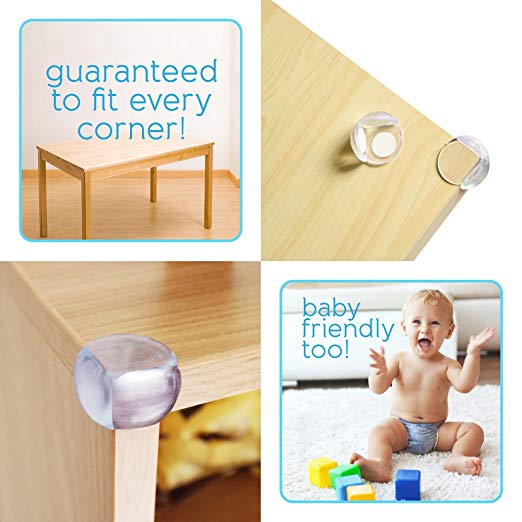
Whenever we’re doing stuff on the counter, be it preparing food or arranging things, we are blindsided. One minute we’re chopping vegetables, and the next, your child runs in the room and you hear a loud cry—your little one has just bumped their head on the chair’s edge.
Parents often notice only what’s above the counter, but most injuries happen below it. That’s because in most households there is plenty of furniture with heights just below the countertops. These furniture can be hazardous, especially for toddlers. So let Ashtonbee help you identify them and give you tips on how to child-proof the under-the-counter furniture.
Things Under the Counters That Can Harm Your Toddler
Plenty of things are short enough to fall in this category, so as a fair warning, this list isn’t an exhaustive one. The list below is composed only of the common household furniture that can cause injuries to your child. Let’s break them down.
Coffee Tables
These types of table furniture are always around knee height. But to our little ones, coffee tables can be at chest or head level. This can be hazardous, especially if they run into it.
Drawers
It’s relatively safe if a drawer is tucked inside, but the risk doubles when toddlers pull it out. The drawer’s edges are exposed and can be used as a climbing ladder by your child, which can also lead to a fall.
Chairs
The square edges of your bar chairs or those untucked square kitchen table chairs are exposed. A toddler may suddenly get head injuries if they run or turn around suddenly while near these things.
Bedside Tables
This type of furniture may not be in the living room, but it can still pose a risk. Its height is still below any typical countertop—the perfect height for your child’s head. If your little one plays around in the bedroom, these things are disasters waiting to happen.

Preventive Measures to Child-Proof Below-the-Counter Furniture
Now that we have identified the types of furniture that cause risk to our children, it’s time to do something about them. Here are some preventive measures you can immediately apply in your home.
Plan Furniture Purchases
We all know the adage, prevention is better than a cure. Knowing this, you’d ideally want to prevent hospital visits because of injuries. So before your little ones become toddlers, you must plan what furniture to get.
Consider furniture with soft and rounded features. If you’re planning your child’s room, consider the appropriate ages for the furniture as well.
Remove or Replace Furniture With Sharp Edges
If you already have furniture items with edges, consider removing or replacing them. Do a thorough scan of your indoor furniture set-up and be on the lookout for the stuff with sharp corners and edges below the counter. Then, remove them from the space or replace them with something rounded and with soft corners.
Keep Floors and Surfaces Clutter-Free
Toys, liquid spills, and other items—big or small—are trip hazards that can increase the risk of your child’s injury. If you already have a toddler running around, ensure the floor and table surfaces are free from clutter so they can move around freely and not lose their balance.
Put an Area Rug or Play Mat on the Floor
Double up the safety and ensure trip hazards are less likely to happen by putting an area rug or a play mat on the floor. Be sure to select one that’s thick and soft. This will serve as a cushion just in case a fall happens. But in most cases, these flooring improvements will help keep your toddler’s balance.
Secure Drawers From Opening
It’s not just your toddler’s feet doing the work when they play and explore. Those little fingers can grab, twist, and pull. So those drawers, if left unlocked, can be pulled out. The drawers’ edges, if exposed, can increase the risk of injuries. So keep them locked or put a cabinet drawer safety lock on them.
Keep Pieces of Furniture Stable
If unstable, those below-the-counter furniture items with sharp edges can be unsafe for your child. Toddlers can do the same maneuver on these pieces of furniture with their small hands. So secure them with anti-tip straps and keep them tucked in the wall corner. This can reduce instability, minimize the exposure of the furniture items’ corners, and maximize protection.
Get Safety Corner Guards for Edges
If there are still items of furniture with sharp edges that you can’t remove, secure them with high-quality corner guards. You can get non-toxic ones made of gel, so they keep furniture edges intact while protecting your walls from scratches.
Test Your Furniture’s Stability
Finally, once you’ve placed all the safety precautions for your furniture pieces, test them out for safety. First, try to wobble the furniture pieces you’ve secured. Then, run your hands on corners and edges and press those plastic corner guards to test how protective they are. Testing your furniture items for safety is the only way to know if your baby-proofing will be effective.
Corner Guards: Your Safety Tool Below the Counter
Edges are the main culprit for baby injuries. This is problematic for parents, especially if the culprit is an item of furniture just below counter-height.
Plastic corner guards will help put your minds at ease as they keep your little ones safe from head or body injuries. These are simple and small items that significantly impact you and your child’s life. If you’re interested in learning more about clear corner guards, you can check out our collection of baby essentials here.



